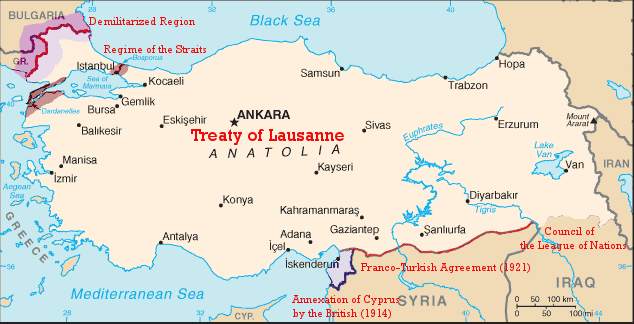.
The Greco-Turkish War of 1919-1922, also called the War in Asia Minor, and (in Turkey) a part of the Turkish War of Independence, was a war between Greece and Turkey fought in the wake of World War I.
Political Background
This political context of this conflict is linked to secret agreements on sharing of Ottoman Empire at the end of WWI. Military history begins with the Armistice of Mudros. The war arose because the western Allies, particularly British Prime Minister David Lloyd George, had promised Greece territorial gains at the expense of the Ottoman Empire if Greece entered the war on the Allied side. These included eastern Thrace, the islands of Imbros and Tenedos, and parts of western Anatolia around the city of Smyrna (İzmir)
In return for the contribution of the Greek army in the war effort, the 1920 Treaty of Sèvres, which ended the First World War in Asia Minor and in parallel determined the future of the Ottoman Empire, assigned eastern Thrace and the millet of Smyrna to Greece.
Around that time Mustafa Kemal, the leader of a group of Turkish revolutionaries, was forming in Anatolia, the Turkish National Movement. The revolutionaries repudiated the Treaty of Sèvres and prepared for defense of what they believed was their national land given up by the weak Ottoman government to the enemy.
Overview of Military Operations
The military operations of the Greco-Turkish war can be roughly divided into three main phases: The first phase, spanning the period from May 1919 to October 1920, encompasses the Greek Landings in Asia Minor and their consolidation along the Aegean Coast. The second phase lasted from October 1920 to June 1921, and was characterised by Greek offensive operations. The third and final phase lasted until August 1922, when the strategic initiative was held by the Turkish Army.
Greek Landings & Consolidation
In May 1919, Greek troops landed on Smyrna (İzmir)and occupied the city and the surroundings under cover of French, British and American ships. The Greeks of Smyrna, who formed the majority of the city's population, and other Christians greeted the Greek troops as liberators. By contrast, the Turkish population saw this as an invading force, as they resented the Greeks and presumably preferred to be under Turkish rule.
The resistance started immediately, mainly by small groups of irregular Turkish troops in the suburbs and the Greeks sustained many losses. In the summer of 1920, the Greek army launched a series of successful offensives. The overal strategic objective of these operations was to provide strategic depth to the defence of Smyrna. To that end, the Greek zone of occupation was extended over all of Western and most of North Western Asia Minor. Greeks already occupied Eastern Thrace.
Greek Expansion
In October 1920, the Greek army advanced further east into Anatolia, with the encouragement of Lloyd George who intended to increase the pressure on the Turkish and Ottoman governments to sign the Treaty of Sevrès. This advance begun under the Liberal government of Eleftherios Venizelos, but soon after the offensive began Venizelos fell from power and was replaced by Dimitrios Gounaris, who appointed inexperienced monarchist officers to senior commands. King Constantine assumed personal command of the army at Smyrna (İzmir). The strategic objective of these operations was to defeat the Kemalist forces and Kemal into peace negotiations. The advancing Greeks were met with little resistance, as the Turks managed to retreat in an orderly fashion and avoid encirclement.
For more details on this topic, see First Battle of Inonu.
The Greek advance was haulted for the first time at the first battle of Inonu on January 11, 1921, and the Allied states proposed to amend the Treaty of Sevrès at a conference in London where both the Revolutionary and Ottoman governments were represented.
For more details on this topic, see Conference of London.
Although some agreements were reached with Italy, France and Britain, the decisions were not agreed by the Greek government, who believed that they still retained the strategic advantage and could negotiate from a stronger point. The Greeks initiated another attack on March 27 (Battle of İnönü II), to be resisted fiercely and finally defeated by the Kemalist troops on March 30. The British favoured a Greek territorial expansion but refused to offer any military assistance in order to avoid provoking the French. The Turkish forces however received significant assistance from the Soviet Union.
For more details on this topic, see Second Battle of Inonu.
In June 1921, a reinforced Greek army advanced afresh to the River Sakarya (Sangarios in Greek), less than 100 km (62 miles) west of Ankara. Meanwhile, the new Turkish government at Ankara appointed Mustafa Kemal as the commander in chief. The advance of the Greek Army faced fierce resistance which culminated in the 21-day Battle of the Sakarya (or Sangarios in Greek)(August 23 – September 13, 1921). The ferocity of the battle exhausted both sides to such an extent that they were both contemplating a withdrawal, but the Greeks were the first to withdraw to their previous lines.
For more details on this topic, see Battle of the Sakarya.
That was the furthest in Anatolia the Greeks had advanced, and within few weeks they withdrew orderly back to the lines they had held in June, intending at least to protect the Smyrna area.
The Greek defeat can be largely attributed to a lack of whole-hearted Allied support, as King Constantine was reviled by the British for his pro-German policies during WWI (in contrast to former prime minister Venizelos). On the contrary, the Kemalist Turks enjoyed significant Soviet support. The main reason though was the poor strategic and operational planning of this ill-conceived advance in-depth. Although the Greek Army was not lacking in men, courage or enthusiasm, it was lacking in nearly everything else. Very soon the Greek Army exceeded the limits of its logistic structure and had no way of retaining such a large territory under constant attacks by regular and irregular Turkish troops fighting in their homeland.
The Stalemate and the Turkish Strategic Offensive
Having failed to reach a military solution, Greece appealed to the Allies for help, but early in 1922 Britain, France and Italy decided that the Treaty of Sèvres could not be enforced and had to be revised. Parallel to their decision, with successive treaties, Italian and French troops evacuated their positions leaving the Greeks exposed.
In March 1922 the Allies proposed an armistice, but Kemal feeling that now he has the strategic advantage, declined any settlement while the Greeks remained in Anatolia and intensified his efforts to re-organise the Turkish military for the final offensive against the Greeks. At the same time, the Greeks strengthened their defensive positions, but were increasingly demoralised by the inactivity of remaining on the defensive and the prolongation of the war. The Turkish offensive was launched on August 26, defeating the Greeks at the Battle of Dumlupınar near Afyon (August 30, 1922, celebrated as the Victory Day and a national holiday in Turkey).
For more details on this topic, see Battle of Dumlupinar.
Having breached the Greek defences, the Turks advanced very rapidly to Smyrna (İzmir), which they captured after the withdrawal of the Greek troops. During the confusion and anarchy that followed, a great proportion of the city was set ablaze, and the properties of the Greeks were pillaged. A massacre of a significant part of the Christian population (including the lynching and brutal murder of the Greek Orthodox Metropolitan Chrysostomos of Smyrna) by the Turkish Army occurred during the days remembered by the Greeks as "the Catastrophe of Smyrna". However, the majority of the Greeks managed to seek refuge on Greek and Allied ships at the harbor of Izmir and other coastal towns.
It has been suggested that the Greek retreat involved a scorched earth policy, which left large tracts of land and property ruined or destroyed. The adherents of this view claim that the burning of crops left the remaining inhabitants of Smyrna close to starvation. However, the validity of this interpretation is questionable considering the haste of the Greek retreat (which was concluded in fewer than 2 weeks), and the lack of any documented evidence of Greek orders to destroy property during the retreat. In any case, most historians today agree that the fire in the city expanded from the burning of Greek and Armenian Quarters of Smyrna by the Turkish Army.
With the possibility of social disorder once the Turkish Army occupied Smyrna, Kemal was quick to issue a proclamation, sentencing any Turkish soldier to death who harmed non-combatants.[1] Few days before the Turkish invasion of the city, Kemal's messengers gave out leaflets with this order written in Greek. The order however was never enforced by the Turkish Army, which set the Christian Quarters of Smyrna on fire and shot civilians on sight.[1]
Resolution

With the borders secured with treaties and agreements at east and south, Kemal was now in a commanding position. The Turks were then able to insist that unconditionally, the Greeks evacuate east Thrace, Imbros and Tenedos as well as Asia Minor, and the Maritza River to be set as the border at Thrace at its pre-1914 position. The majority of the ethnic Greek population of Asia Minor had already fled or been expelled to Greece. Greeks call this the "Asia Minor Disaster".

Boarders of Lausanne
Resolution
The Armistice of Mudanya was concluded on October 11, 1922, with the Allies retaining control of east Thrace and the Bosporus, but the Greeks evacuating these areas. The agreement came into force starting October 15, one day after the Greek side agreed to sign it. The Armistice of Mudanya was followed by the Treaty of Lausanne, under which a significant provision was the exchange of populations.
- For more details on this topic, see Armistice of Mudanya.
- For more details on this topic, see Treaty of Lausanne.
- For more details on this topic, see Exchange of populations between Greece and Turkey.
1 a b M. Glenny, The Balkans
Links
Red Cross Report on the Greek-Turkish Conflict
| Ancient Greece
Science, Technology , Medicine , Warfare, , Biographies , Life , Cities/Places/Maps , Arts , Literature , Philosophy ,Olympics, Mythology , History , Images Medieval Greece / Byzantine Empire Science, Technology, Arts, , Warfare , Literature, Biographies, Icons, History Modern Greece Cities, Islands, Regions, Fauna/Flora ,Biographies , History , Warfare, Science/Technology, Literature, Music , Arts , Film/Actors , Sport , Fashion --- |
Retrieved from "http://en.wikipedia.org/"
All text is available under the terms of the GNU Free Documentation License

